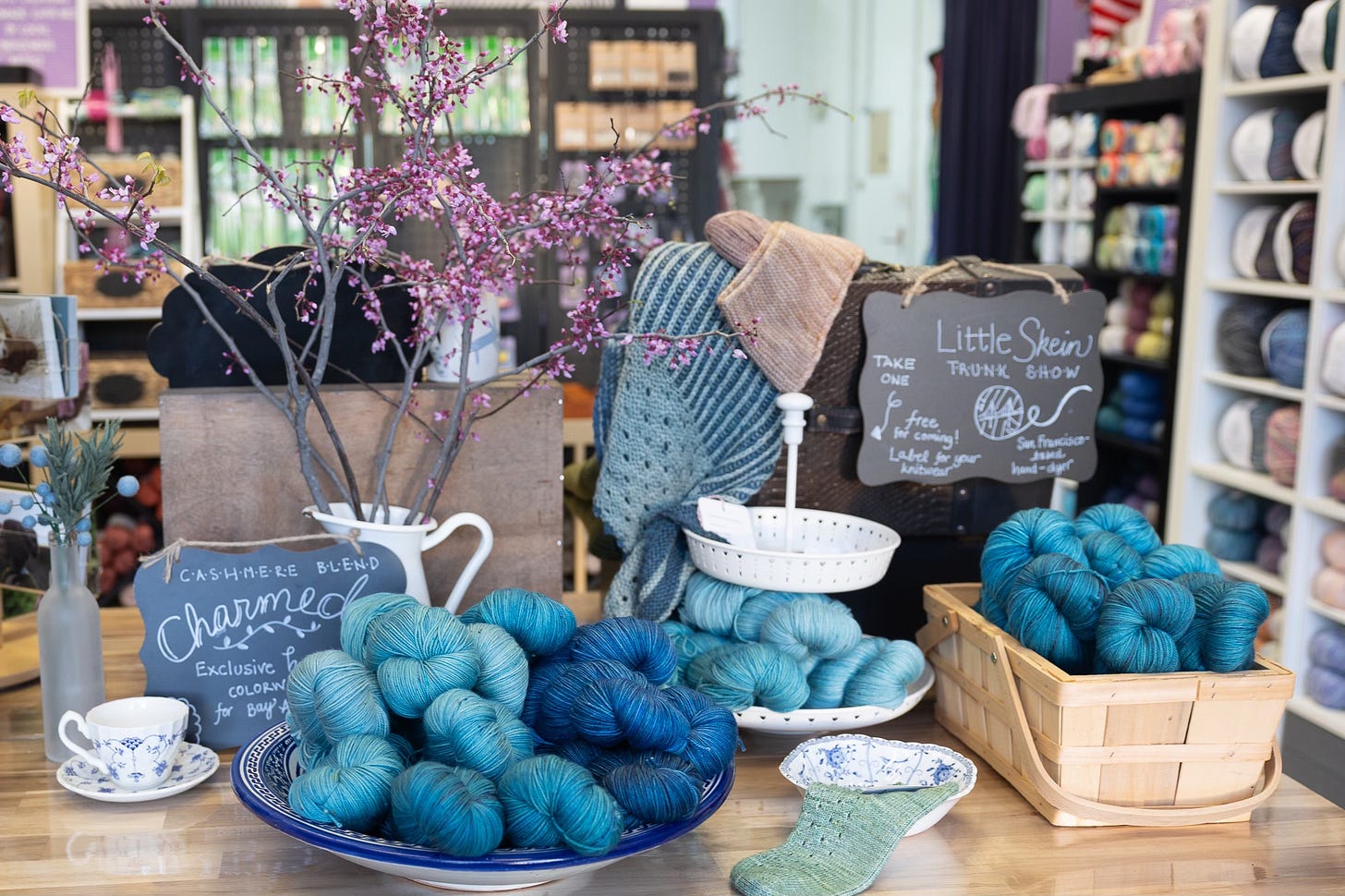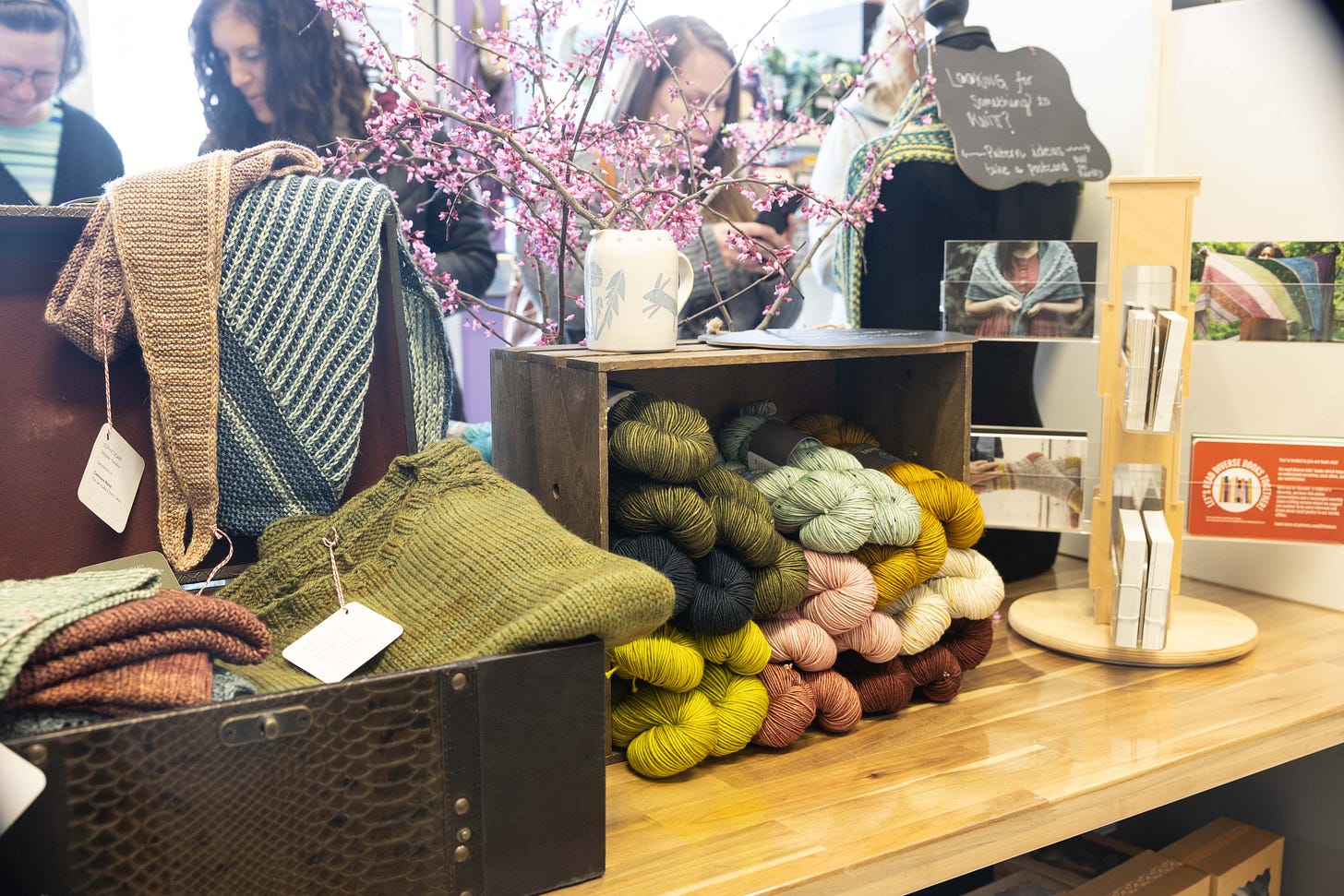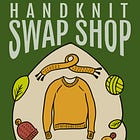Yarn may not be the answer to everything, but it may be the answer to more than you think
A review of the 2025 Bay Area Yarn Crawl

I’ve spent the past week mainly resting.
It feels indulgent and privileged to say so, and even as I’m writing these words, I want to list all the things I’ve ticked off my To Do list while also resting. My Calvinist work ethic runs deep and always tugs at me to prove that I’ve been good enough or have done enough to rest.
But, the truth is: I needed the rest, and resting when you’re tired—without guilt or having to have “earned” it—is something I want for everyone.
The reason I was tired was that I spent the better part of March preparing for and participating in the Bay Area Yarn Crawl, a 10-day event where 22 local yarn shops and dozens of local indie yarn dyers, designers, and teachers hosted events, classes, and trunk shows, and offered special kits, yarn colorways, stitch markers, and project bags. The event reminded me of Stitches West, which, for many, many years, was one of the biggest fiber events in the country, with over 250 vendors. Unlike Stitches West, however, the BayCrawl fits me better. Let me explain.
Stitches West was a four-day fiber show that usually involved a month of preparation. I would test out booth layouts and often purchase new fixtures (one year, I even had a couch and resting area for customers). I would dye hundreds of skeins of yarn in advance and make hundreds of project bags, kitting everything up for in-person shopping, which is wholly different from the more streamlined and utilitarian way I store inventory in my studio. I generally invested around $10,000 in inventory, labor, and expenses to participate. For a small business like mine and a person like me who leans toward anxiety, that’s a lot. The bar to make the show a profitable event is high, and I would be understandably wired until sales were substantial enough to show a net gain.
There is also social pressure in an event like this. Some people are lucky enough that they don’t notice what other people are doing or where lines are forming, but other folks, like me, are hyper-aware because of circumstance or biology. It takes a lot of emotional energy to stay centered and focused on what’s happening in my sales booth and not compare myself to others.
I had a booth at Stitches West for four consecutive pre-pandemic years. It was wonderful to see customers in person, year after year, but being part of that show also stretched me past my maximum capacity year after year. I think many of us can relate to this feeling: pushing through because it needs to be done.
I had a wholly different experience with the Bay Area Yarn Crawl, and it made me think about how, at the best of yarn events or in effective social change, everyone has a part to play, but yours may look different than mine, and no one person has to do everything.
My experience started nine months ago when I was invited to do a trunk show at a new-to-me shop recently opened by a long-time customer and yarn colleague. I’ve been the one to initiate nearly every collaboration or connection I have in the yarn world, and the experience of being invited was … unexpected and utterly delightful.
The yarn shop is Coven of Stitches, located in a charming downtown area of Alameda, a little coastal town right across the Bay from me. It’s a small shop full of handmade creations (including some fantastic, large, felted tentacles in the window), complete with a shop dog, Beatrice.
Maybe because I had spent so much time during the pandemic rethinking my business and resizing it to fit me, or maybe because the shop owner and I share core values, it was smooth and easy to work out financial and exhibit terms that worked for them and me. I had leeway to install my trunk show with fresh flowering cherry tree branches and bits of blue-and-white china from my personal collection. It was a small version of the retail exhibit I would have had at Stitches West—and well-suited to the current iteration of my business.
I was able to do all my hard work in advance: creating the show colorway, dyeing yarn, transporting fixtures, planning and installing the exhibit, and even making a second trip back to the shop with the yarn labels I’d forgotten. And then, I could hand the baton over to Coven of Stitches to greet yarn crawlers. They did the hard and social work of hosting customers and selling yarn. I could recharge at home, dye more yarn, restock mid-week, and then join the event on its second weekend for a few hours in person.
The difference in these two events reminds me of my earlier career days in the nonprofit world and learning about social scientist Robert Putnam’s theory (and book) Bowling Alone. In the early 2000s, he posited that Americans were becoming more isolated and disconnected from one another—that they were quite literally “bowling alone” rather than in leagues. With a copious amount of data, Putnam demonstrated “that America was transforming from a nation of joiners to a nation of loners.”1
Twenty-five years ago, Putnam warned that we were losing the very thing that made America unique: our charitable and connected mindset. This is the uniquely American trait of pitching in to help one’s neighbor and forming voluntary associations in which to do so.
Forming or being part of a voluntary association can be as “simple” as the people who got together to create the yarn crawl. But this was actually far from simple. Voluntary associations have many moving parts, requiring considerable behind-the-scenes unpaid labor.
Yet, this idea that people can come together to create something that benefits a larger group of people is uniquely and quintessentially American.
In the 1830s, Alexis de Tocqueville, a French civil servant from an aristocratic family, spent nine months visiting the United States, and what he observed and documented in his account of this journey, Democracy in America, has influenced political thought ever since. He contrasted what he saw naturally occurring in America with Europe's more isolated and aristocratic constructs. He wrote:
“In the United States, as soon as several inhabitants have taken an opinion or an idea they wish to promote in society, they seek each other out and unite together once they have made contact. From that moment, they are no longer isolated but have become a power seen from afar whose activities serve as an example and whose words are heeded.” (Tocqueville 1840, 599)
He believed that “associations extend democracy beyond the scope of elected offices to the level of people who share a common interest around which they effect action for large groups of people. By forming and joining associations, Americans are casting a sort of ballot about the issues which are important to them, their families, and their communities.”2
I saw this in action during the yarn crawl. From the notes and emails I’ve gotten from a few of you, other people noticed it, too.
The crawl uplifted the copious indie dyer and designer talent we have in the Bay Area. At Coven of Stitches, my trunk show was one of four in residence. The crawl also featured more than just yarn to buy. There were social activities: a movie night, craft-together events, and a pre-crawl knitalong (which I will totally be joining next year). I saw groups of friends who were “crawling” together. I saw young families and got to make faces at some adorable babies. I saw people picking out yarn colors for each other and excitedly sharing details about the gorgeous knitwear they were wearing.
It wasn’t a yarn utopia. But it was something unique and as close to inclusive as I’ve felt in a yarn event. While an event like this centers on buying yarn, the vibes were distinctly community, not commercial.
Everyone had a part to play, and no one person had to do everything.
I can rest while you exert, and you can rest while I exert.
So that’s what I’ve been doing this past week. I've been resting and getting ready for the next sprint.
Swap Shop for handknits & crocheted items
This event is something I liken to “a free e-Bay for knitwear.” Paid subscribers to my newsletter review their knitwear and crochet collections and identify things that no longer fit their bodies or styles. They send the details to me (or ask for my concierge service); I turn the information into shoppable listings, and then I open the “shop” for claiming.
The knitwear or crochet items are free, and the claimant pays for shipping. I held a pilot round of the Swap Shop last summer, and it was a deeply meaningful experience—for folks who offered knitwear and got to rehome items that no longer suited them as well as for folks who claimed knitwear and received the care and luxury of a handmade item that perfectly suited them.
The Swap Shop feels like community at its finest.
For me, it’s a fair amount of work but also not an overwhelming amount of work. I love setting up the systems and templates, and I’m well set up to do the other parts of the work—things like photographing for folks who need concierge service or issuing mailing labels for claimed items. It’s a nice Venn diagram of something useful, something I like doing, and something that builds connection and community.
Items are now coming in to me daily, and I have a few concierge service requests to fulfill (which take a bit longer because I need to wait for the physical knitwear to reach me), so it now looks like the Swap Shop will open for claiming soon. I’ll keep you posted.
This slightly later than anticipated date means that you have time to upgrade your membership to paid and sort through your knitwear if you’d like to rehome an item or two. Paid members also get first dibs on claiming items once the shop is open.
You might also like to read:
Read more about Bowling Alone in this recent profile of Robert Putnam in the New York Times (gift link).
Learning to Give, part of the Council of Michigan Foundations










I love this because I read an article during the Orange Potatoes' last presidential holding that said, “To defeat Trump, the greatest gains are those that are small and local.” I love this because I am one of those weirdos who run around reminding people to vote during local elections.
I would've loved to do the crawl but I live in so Cal and you're just a bit too far for me to drive at the moment. There was a time when I aspired to move north, but life had other ideas. I loved reading about it though. I consider Substack as one of my communities that boost me and feed me, especially the creative community because we're all so supportive. Now that my well is filled, I'm off to work on a second sock.